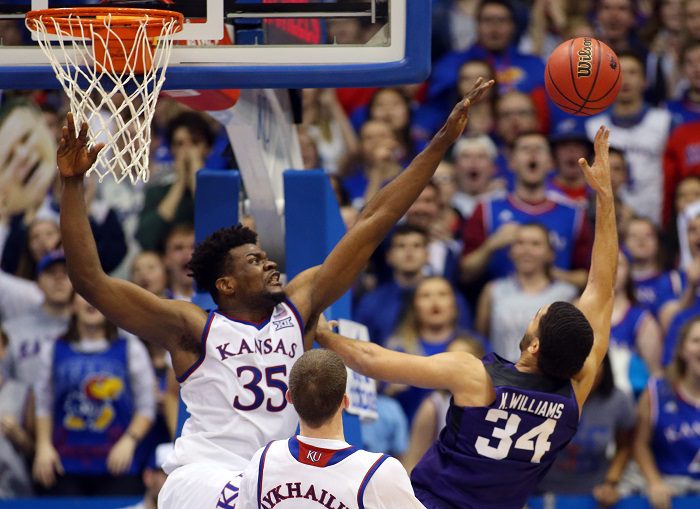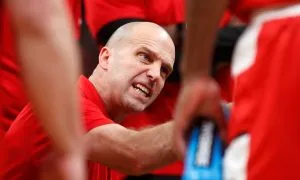Ranking the Top 25 Returning Big 12 Basketball Players: No. 10-6

Selecting the Big 12 Conference’s Top 25 returning players for the 2019-20 basketball season was a difficult task.
Today we continue our Top 25, beginning with Nos. 6-10 as we run up to heading to Kansas City for Big 12 Media Day at the Sprint Center. At some point during the five days these stories run, you’re going to hate me. That’s cool. That’s part of the job. Hit me up on Twitter at @PostinsPostcard if you agree or disagree. Or both. I’m happy to reply when I can.
Before we begin, here is some context for the selections.
First, any player considered must have played in the Big 12 last season. So, if you’re looking for our Freshman, Transfer or Rising Player stories, we ran those earlier this offseason. Those players won’t be included here.
Second, I watched about 75 percent of last season’s Big 12 league games, attended the Big 12 Tournament in person and watched about 25 percent of last season’s non-conference games. I won’t claim to be an expert, but I’ve done my best to see every possible returning player several times, either on TV or in person.
Third, I am not “projecting” performance for the coming season. That will probably end up being the most disagreeable thing about this Top 25. I can’t project how players have improved over the summer or how they may fit in the configuration of their respective teams this coming season. There are too many factors at play. So the rankings are based on their performance last season. I felt that was the fairest way to accomplish this task, much like our Top 25 player rankings for football and baseball. I will, however, provide a small sentence or two about how each player could fit into their team’s season. But it wasn’t a consideration for the rankings.
In case you missed it, here is the link to our story on Nos. 21-25.
In case you missed it, here is the link to our story on Nos. 16-20.
In case you missed it, here is the link to our story on Nos. 11-15.
So which players are Nos. 6-10? Let’s get started.
No. 10 — C Udoka Azubuike, Kansas
When you talk with Kansas head coach Bill Self he will tell you that Azubuike is one of his team’s most important players, and last year’s struggles inside without him underscore that importance. Azubuike draws double teams and creates seams and openings for others players. But this isn’t a “important player” list. In the context of the talent within the conference, to me, Azubuike is just barely a Top 10 player. His talents boil down to rebounding, dunking and shot blocking, which are certainly helpful to Kansas. His averages last year in nine games were 13.4 points and 6.8 rebounds per game. He played one Big 12 game, scoring 8 points, grabbing 9 rebounds and blocking two shots against Oklahoma in a 7-point win. But he’s the conference’s worst free throw shooter, which makes him a liability in close games. He’s not a particularly good passer inside and he’s had turnover issues (he averaged 2 per game in nine games in 2018-19). When you get to Top 10 players, you’re looking for players that are as well-rounded as possible. Azubuike’s production as an inside scorer and rebounder make up for some of that, but not enough in my mind to be higher on this list.
Entering this season: He needs to show improvement in his free-throw shooting, mid-range game and ball possession. If he shows improvement in all three of those areas, then his selection as the Big 12 Preseason Player of the Year for 2019-20 by the league’s coaches would certainly be justified.
No. 9 — G Matt Coleman III, Texas
An honorable mention Big 12 selection a year ago, Coleman ended last season with 9.8 points per game and 2.1 rebounds per game. Had the Longhorns not rotated so many guards, Coleman’s numbers might have been a little better. But there is more to Coleman than the scoring average. He was among the Big 12 leaders in assists per game (3.4), fourth in assist-to-turnover ratio (2.0) and Top 20 in minutes played. Now, in Big 12 games, Coleman’s numbers ticked up to 10.2 points per game, 4.3 assists per game (behind only TCU’s Alex Robinson) and third in free-throw percentage (83 percent). His assist-to-turnover ratio also improved (2.8) and was second behind Iowa State’s Tyrese Halliburton. He showed improvement from non-conference to conference, and during the NIT run Coleman showed his leadership and floor presence in a way that I hadn’t seen before. Those intangibles matter when you’re running an offense. The postseason agreed with him. His defense became better, too. He became more important to Texas’ success as the season progressed. And his talent was there for all to see.
Entering this season: The departure of Kerwin Roach leaves the path to being the Longhorns’ top-scoring guard wide open for Coleman, who should contend for All-Big 12 First- or Second-Team honors assuming he improves.
No. 8 — F Cameron McGriff, Oklahoma State
McGriff was an honorable mention All-Big 12 selection last season, but he played well enough to earn third-team honors, at the least. McGriff was the interior focal point for an undermanned Oklahoma State team. His 12.3 points per game was No. 11 in the Big 12 for the entire season, while his 7.4 rebounds per game was second behind only Kansas’ Dedric Lawson. McGriff was also a Top 10 free-throw shooter (76.4 percent), a Top 12 shot blocker (0.8 per game) and a Top 6 offensive rebounder (2.2 per game). Only four Big 12 players logged more minutes per game for the season than McGriff. He also had the third-most double-doubles (7) of any Big 12 player. In Big 12 action he didn’t let up, and he turned up the defense with 1.3 steals per game, good for No. 13 in Big 12 games. McGriff was one of the grittiest players in the Big 12 last year, and boasted strong production to back it up.
Entering this season: The development of Yor Anei in the post is important for McGriff. If Anei has grown as a player, that would allow McGriff to settle back more fully into the power forward role to which he’s best suited. McGriff will be a handful for any Big 12 team.
No. 7 — G Lindy Waters III, Oklahoma State
The difference between McGriff and Waters is razor-thin, frankly. Waters, like his teammate, was an honorable mention selection in 2018-19 and played well enough to be considered higher on that honor roll. Waters scored 12.2 points per game last season, juts a tenth of a point behind McGriff. While Waters wasn’t the rebounder McGriff was, he contributed in other areas, finishing among the Big 12’s leaders in assists per game (2.8), free-throw percentage (87.8), steals (1.3), 3-point percentage (44.8) and 3-pointers made per game (2.2). Still, I found one small separation. Waters was among the Top 15 in field goal percentage in Big 12 play. McGriff was not. When you consider how far away Waters played from the basket compared to McGriff, that stands out a bit. By season’s end Oklahoma State’s success or failure was dependent on both of them, but I felt Waters kept the Cowboys in games more often down the stretch.
Entering this season: He’s Oklahoma State’s best all-around player entering the season, followed closely by McGriff. Modest improvement puts him on track to contend for first-team or second-team status in the conference (but it will be a crowded race).
No. 6 — F Kristian Doolittle, Oklahoma
Last season we saw the Kristian Doolittle head coach Lon Kruger and the Oklahoma Sooners have been waiting on for two years. Doolittle earned the Most Improved Player in the Big 12 award last year, along with Third-Team honors. For the season he averaged 11.3 points and 7.1 rebounds per game. Now, the Sooners knew THAT Doolittle was in there — he averaged more than 9 points per game his first collegiate season. But last season’s totals were career highs and represented the first season Doolittle looked dominant inside as opposed to simply “being” inside. His field-goal percentage was seventh in the Big 12 (50.2), his free-throw percentage was eight (77.5 percent) and he was second in the league with 5.7 defensive rebounds per game. In Big 12 games his scoring average was two points higher than the season average (13.9), he became a more assertive shot-blocker (.6 per game) and he cleared nearly one more defensive rebound per game than for the entire season. By season’s end he was a forward you didn’t want to mess with.
Entering this season: He has a solid blend of athleticism and back-to-the-basket game makes him one of the players to watch going into the season. More improvement means he could be a double-double machine in 2019-20. He had five last season. The coaches selected him a preseason honorable mention.
Next up: Nos. 1-5.
**We now have FREE Big 12 Forums here at Heartland College Sports. Go sign up here and join our conversation! **
























